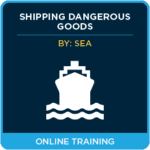
If you are shipping dangerous goods there are different regulations that you need to be aware of. Your staff must remain up to date on these regulations by taking part in relevant training. At ICC, we provide the essential training your staff needs to ensure compliance, avoid heavy fines, and delays.
Shipping Dangerous Goods in the U.S.A
When transporting dangerous goods by ground in the U.S.A., employees must follow regulations listed in Title 49 of the U.S. Code of Federal Regulations (49 CFR). Issued by the Pipeline and Hazardous Materials Safety Administration (PHMSA) and the U.S. Department of Transportation (DOT), these regulations govern the transportation of dangerous goods in the U.S.A. When goods are being exported or imported by sea and air, compliance with International Air Transport Association (IATA) regulations and International Maritime Dangerous Goods Code (IMDG), in addition to 49 CFR is also required.
ICC training provides information needed to ship products in compliance with 49 CFR and IATA Dangerous Goods Regulations. Students who complete this course are issued a certification that is valid for 2 years, per IATA Dangerous Goods Regulations and other national transport regulations.
Topics covered under this training:
- Overview of regulations affecting transport of hazardous materials
- Structure of 49 CFR and IATA
- Classification and Proper Shipping Names
- Packaging, marking, labeling and placarding
- Shipper responsibilities and documents
- Training requirements
- Security awareness
- State, operator, and carrier variations
- Exemptions, exceptions, and special provisions
Shipping Dangerous Goods in Canada
The shipping, handling, or transporting of dangerous goods in Canada requires training per Transport Canada’s standards. Canada’s Transportation of Dangerous Goods (TDG) regulations cover transport by road, rail, and domestic water and require shippers, carriers, and handlers to meet strict safety and hazard communication requirements.
ICC offers classroom, on-site and online training options for shipping dangerous goods in Canada. The general awareness program offers TDG training and your responsibilities under them; along with how to recognize dangerous goods for transport. The transportation of dangerous goods in small quantities covers the basic requirements of TDG and IATA regulations along with specific procedures for shipping goods such as consumer commodities, limited quantities, small quantities, expected quantities, and de minimis quantities. We also offer online training for shipping dangerous goods by ground in Canada and US/Canada transborder training for shipping dangerous goods by ground.
Topics covered:
- Overview of regulations affecting dangerous goods
- Structure of the Transportation of Dangerous Goods Regulations (TDGR)
- Shipper’s and carrier’s responsibilities
- Training requirements
- Using list of dangerous goods (numerical and alphabetical)
- Emergency Response Assistance Plan (ERAP) requirements
- Special cases and exemptions
- Brief overview of the applicable provincial and transborder regulations
Shipping Dangerous Goods by Air
Shipping goods internationally requires compliance with both the International Civil Aviation Organization (ICAO) technical instructions, as well as national regulations. To meet commercial standards, shippers must also comply with IATA Dangerous Goods Regulations.
At ICC, we offer Entry-level and Intermediate training courses for shipping dangerous goods by air using IATA regulations. The training modules are attended for shippers, packers, cargo agents, freight forwarders, and operator personnel who are responsible for the preparation of hazardous materials by air transportation.
Topics covered:
- Overview of national and international regulations on transport of dangerous goods by air
- Shipper’s responsibilities
- Training requirements
- State and operator variations
- 7 Steps to Compliance
- Use the list of dangerous goods
- Limited quantities
- Excepted quantities
Shipping Dangerous Goods by Sea
Sea transportation is one of the most cost-effective ways to ship dangerous goods. However, strict rules apply through the Safety of Life at Sea (SOLAS) agreement and the International Marine Organization (IMO). Therefore, international shipments must comply with both the International Maritime Dangerous Goods Code (IMDG) and national transportation regulations.
ICC offers comprehensive shipping by sea IMDG course that covers the most current IMDG code including amendment 37-14. Students who complete this course receive a certification that holds an expiry of 3 years.
Topics covered:
- Overview of national and international regulations on transport of dangerous by ocean
- Structure of the IMDG code
- Shipper’s responsibilities
- Training requirements
- 7 Steps to Compliance
- Use the list of dangerous goods
- Limited quantities
- Segregation requirements
- Amendments and updates
Read our guide to learn more about all the procedures associated with shipping dangerous goods.
Shipping Biological Substances & Dry Ice
Biological substances and dry ice are transported from hospitals, medical clinics, and scientific research locations daily. Special rules apply for the transport of these potentially infectious agents, as well as the cooling agents used to preserve them.
ICC’s training on shipping biological substances & dry ice is essential in learning how to classify and prepare these substances correctly for transport. Students who complete this course are issued a certification that is valid for 2 years, per IATA Dangerous Goods Regulations and other national transport regulations.
Topics covered under this training:
- Overview of national and international regulations on transport of biological substances and cooling agents such as dry ice
- Shipper’s and carrier’s responsibilities
- 7 Steps to Compliance
- Exceptions from the regulations
- Amendments and updates, including new categories for infectious substances
Safe Transportation of Radioactive Materials
This training provides information for shipping radioactive materials by air (using the IATA Dangerous Goods Regulations) and ground (in Canada under the Transportation of Dangerous Goods Regulations and in the USA using the 49 CFR hazardous materials regulations).
Topics covered under this training:
- Introduction to National and International Regulations
- Classification of Radioactives
- Obtain the Shipping Description
- Packaging for Radioactives
- Marking and Labeling
- Documentation
- Placarding, Loading and Handling
- Reporting
- Security Awareness
Shipping Lithium Batteries
In recent years, ICAO, IATA, 49 CFR, IMO, and TDG have implemented significant changes to the way lithium batteries need to be classified, labeled, and packaged. ICC offers training courses that focus on how to ship lithium batteries by different modes of transport in U.S.A. and Canada.
These courses will follow the 7 Steps to Compliance to teach you how to ship medium and large batteries, as well as using the exemption for small batteries.
If you have any questions or want to learn more about our training courses, please contact us.
We have all the products, services and training you need to ensure your staff is properly trained and informed.
 Shipping Dangerous Goods by Air |
 Shipping Dangerous Goods by Ground in the U.S.A. |
 Shipping Dangerous Goods by Ground in Canada |
 Shipping Dangerous Goods by Sea |






 ICC USA
ICC USA ICC Canada
ICC Canada